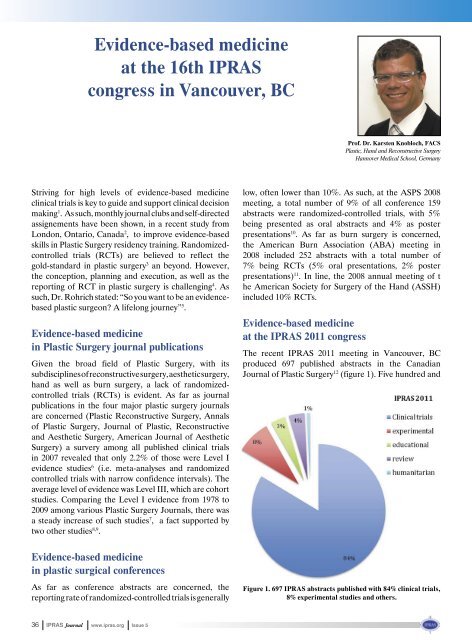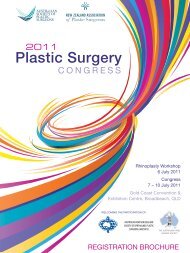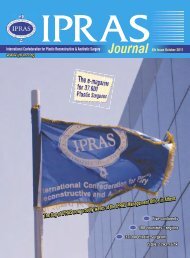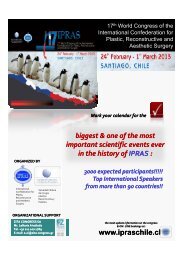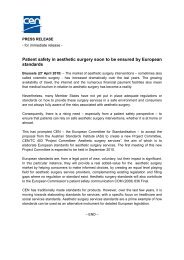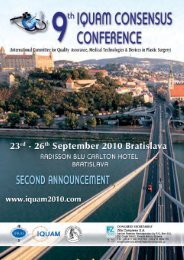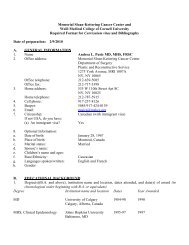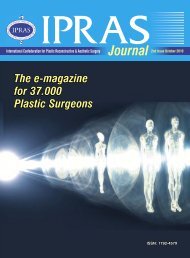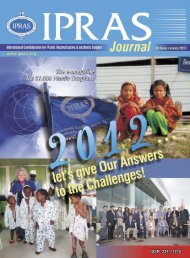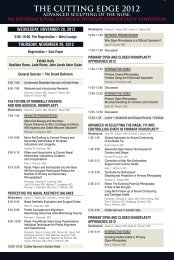Download pdf file - International Confederation for Plastic ...
Download pdf file - International Confederation for Plastic ...
Download pdf file - International Confederation for Plastic ...
You also want an ePaper? Increase the reach of your titles
YUMPU automatically turns print PDFs into web optimized ePapers that Google loves.
Evidence-based medicine<br />
at the 16th IPRAS<br />
congress in Vancouver, BC<br />
Striving <strong>for</strong> high levels of evidence-based medicine<br />
clinical trials is key to guide and support clinical decision<br />
making 1 . As such, monthly journal clubs and self-directed<br />
assignements have been shown, in a recent study from<br />
London, Ontario, Canada 2 , to improve evidence-based<br />
skills in <strong>Plastic</strong> Surgery residency training. Randomizedcontrolled<br />
trials (RCTs) are believed to reflect the<br />
gold-standard in plastic surgery 3 an beyond. However,<br />
the conception, planning and execution, as well as the<br />
reporting of RCT in plastic surgery is challenging 4 . As<br />
such, Dr. Rohrich stated: “So you want to be an evidencebased<br />
plastic surgeon? A lifelong journey” 5 .<br />
Evidence-based medicine<br />
in <strong>Plastic</strong> Surgery journal publications<br />
Given the broad field of <strong>Plastic</strong> Surgery, with its<br />
subdisciplines of reconstructive surgery, aesthetic surgery,<br />
hand as well as burn surgery, a lack of randomizedcontrolled<br />
trials (RCTs) is evident. As far as journal<br />
publications in the four major plastic surgery journals<br />
are concerned (<strong>Plastic</strong> Reconstructive Surgery, Annals<br />
of <strong>Plastic</strong> Surgery, Journal of <strong>Plastic</strong>, Reconstructive<br />
and Aesthetic Surgery, American Journal of Aesthetic<br />
Surgery) a survery among all published clinical trials<br />
in 2007 revealed that only 2.2% of those were Level I<br />
evidence studies 6 (i.e. meta-analyses and randomized<br />
controlled trials with narrow confidence intervals). The<br />
average level of evidence was Level III, which are cohort<br />
studies. Comparing the Level I evidence from 1978 to<br />
2009 among various <strong>Plastic</strong> Surgery Journals, there was<br />
a steady increase of such studies 7 , a fact supported by<br />
two other studies 8,9 .<br />
Evidence-based medicine<br />
in plastic surgical conferences<br />
As far as conference abstracts are concerned, the<br />
reporting rate of randomized-controlled trials is generally<br />
36 IPRAS Journal www.ipras.org Issue 5<br />
low, often lower than 10%. As such, at the ASPS 2008<br />
meeting, a total number of 9% of all conference 159<br />
abstracts were randomized-controlled trials, with 5%<br />
being presented as oral abstracts and 4% as poster<br />
presentations 10 . As far as burn surgery is concerned,<br />
the American Burn Association (ABA) meeting in<br />
2008 included 252 abstracts with a total number of<br />
7% being RCTs (5% oral presentations, 2% poster<br />
presentations) 11 . In line, the 2008 annual meeting of t<br />
he American Society <strong>for</strong> Surgery of the Hand (ASSH)<br />
included 10% RCTs.<br />
Evidence-based medicine<br />
at the IPRAS 2011 congress<br />
Prof. Dr. Karsten Knobloch, FACS<br />
<strong>Plastic</strong>, Hand and Reconstructive Surgery<br />
Hannover Medical School, Germany<br />
The recent IPRAS 2011 meeting in Vancouver, BC<br />
produced 697 published abstracts in the Canadian<br />
Journal of <strong>Plastic</strong> Surgery 12 (figure 1). Five hundred and<br />
Figure 1. 697 IPRAS abstracts published with 84% clinical trials,<br />
8% experimental studies and others.


